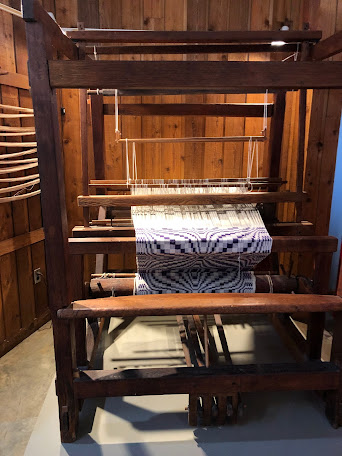I love this book; Mary Madison extracted its contents and carefully culled from WPA records and the Library of Congress.
Note: I apologize for the line height discrepancies, it appears that I must edit in html to fix this, not my strong suit!
I am also reading an article, "The Material World of Cloth: Production and Use in Eighteenth Century Rural Pennsylvania" by Adrienne D. Hood, published in the Mary and William Quarterly and available by logging in at JSTOR. Among the many other fascinating things mentioned is that different qualities of fabric were woven in the 1700's in Pennsylvania, and the highest qualities were often imported, such as fine linen from Ireland.
What strikes me from Madison's book is the very high quality of fabrics that could be produced, in addition to coarser cloths that were undoubtedly faster to produce as shortcuts could be taken in production, less fine fiber spun, and fewer ends per inch woven.
Osnaburg
"Draw's" (drawers) might be made made from osnaburg. Doesn't sound particularly comfortable!
I had thought that osnaburg was imported from Europe owing to it's name from Osnabrück from which it was probably originally imported. However it is a coarse plain weave fabric that naturally was easily produced on this side of the Atlantic, to the extent that turning flax into linen or tow is easy. According to Wikipedia, it could be flax, hemp, or jute. I recall reading in Rinker Buck's "The Oregon Trail: A New American Journey" (also recommended) that Osnaburg covered those covered wagons.
Enslaved persons would knit "sox". Darning of socks of course was done.
Spinning
Children spun cotton as soon as they were old enough to. A corn shuck or husk would be used as a "broach" to hold spun thread. Ropes were of course also spun and created. wool and cotton lint might be combined then spun. Thread that was spun was noted to be as fine as today's sewing thread. A shuck "broach" might be put on a spinning wheel spindle to easily slide the spun thread off and as a way of storage. Both the hand turned great wheel and flyer lead wheels are mentioned.
So, cotton grown on plantation was used to make their own clothing and not just for export to England. Spinning cotton into a thread is hard and something that will take me a long time to master. I know from this reading that they might have been using a spinning wheel. Click reels might be used to measure out skeins of cotton as it was spun. Amounts were important to know as daily quotas were set.
Coverlets
Coverlets were woven with thread dyed with a variety of colors. Here's a photo of some coverlet samples on display at the Southern Highland Craft Guild, that I took a couple of years ago.
Natural Dyes
Natural dyes including black walnut bark dye, indigo, red earth. Copperas was both a dye and a mordant; Salt combined with vinegar was also used as a mordant in the dye pot. "All colors of the rainbow" could be achieved. Dyers along with all the craftspeople were highly skilled.
Weaving
A child might kneel next to the loom and throw the "sheckle". Weaving might occur in a designated room in the house so that it could be supervised by the mistress of the house, or in a separate weaving shed.
Photo of a barn loom taken by me at the Southern Highland Craft Guild several years ago.
Fabric
A variety of fabrics with respect to fiber content were produced. One person describes a cloth with 3 strands cotton and 2 of wool. Double weave for winter clothing although sometimes wore cotton in winter or a wool mix. "Jeans" was woven to make men's suits out of, presumable this would have been a twill. "Gusta" was another type of coarse woven fabric. I could not find any source for this name. "Nits and lice" coarse cloth for overalls that look like speckles
I'm fascinated with jeans (the garment) and their history. The term "jeans," according to this Wikipedia entry, says that the term "jeans" referring to the fabric, may have been derived from Genoa, where the particular weave (a twill?) used in jeans-the-garment originated. The French word for Genoa is "Gêne," hence the term "jean."
Clothing
A number speak of "good warm clothes" woven especially for winter, in one instance the interviewee speaks of "plenty of clothes", another says that given two complete outfits were given twice a year, one summer one winter. During the Civil War, white owners and families wore homespun (could not purchase ready made presumably). Enslaved people might weave fabric for poorer whites who could produce thread but not weave it. Adrienne Hood notes that in comparison to households with looms, there were many many more households with spinning wheels, in 18th century Pennsylvania.
Work
Fabric producers were sometimes made to work until late or all night
Cotton ginning and pressing
Cotton gins might have treadmills to walk in like stairs, but gins were also turned by mule. The cotton was fed by hand which was quite dangerous. then treaded by hand to compress it or a bale press was used. It was also noted in the book that sometimes seeds were removed from cotton by hand.
There is an old bale press in Latta South Carolina. Here's a link with info https://en.wikipedia.org/wiki/Cotton_Press_%28Latta,_South_Carolina%29 and a photo courtesy of Wikipedia.






No comments:
Post a Comment